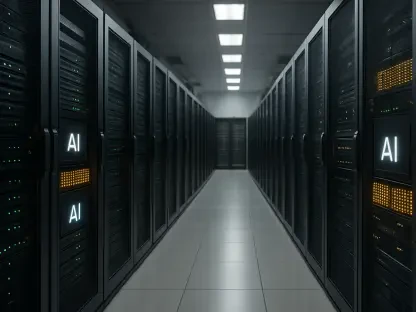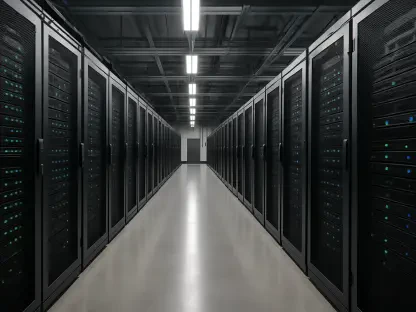What happens when the insatiable hunger of artificial intelligence for computational power clashes with the pressing need to safeguard the planet? In the heart of Europe, a quiet revolution is unfolding as data centers emerge as critical battlegrounds for this very conflict, with sprawling facilities humming with activity, powering AI algorithms that shape daily life, yet consuming energy at an alarming rate—equivalent to small cities in some cases. This tension between technological advancement and environmental responsibility sets the stage for an urgent conversation, one that a company named Verne is boldly addressing with innovative solutions across Finland, Iceland, and the UK.
The significance of this story lies in its far-reaching implications. AI is no longer a futuristic concept; it drives everything from personalized recommendations to complex medical diagnostics, with global data center energy consumption projected to double by 2030 if unchecked, according to recent industry estimates. Verne’s mission to balance the immense demands of AI workloads with sustainable practices offers a blueprint for the future, not just for tech giants but for policymakers and businesses worldwide. This narrative is about redefining how digital infrastructure can grow without compromising the environment, a challenge that affects every sector in an increasingly connected world.
The Growing Strain of AI on Data Centers
The explosion of AI technologies has placed unprecedented pressure on data centers, which serve as the backbone of digital innovation. High-performance components like GPUs and TPUs, essential for training AI models, consume vast amounts of electricity, often pushing facilities to their operational limits. A report from Moody’s highlights that hyperscalers and neocloud providers risk overbuilding infrastructure to meet this demand, leading to inefficiencies and heightened environmental impact.
This strain is not merely technical but deeply tied to global sustainability goals. As AI adoption accelerates, the energy footprint of data centers could undermine efforts to reduce carbon emissions, with some studies estimating that the sector accounts for nearly 2% of global electricity usage today. Verne, with operations in Nordic regions and the UK, steps into this arena with a commitment to tackle these dual challenges head-on, prioritizing both performance and planetary health.
The stakes are high, as failure to address this issue could stall technological progress or exacerbate climate concerns. Verne’s focus on scalable, eco-friendly solutions positions the company as a key player in ensuring that AI’s growth does not come at an irreversible cost. Their approach signals a shift in industry thinking, where sustainability is not an afterthought but a core design principle.
Verne’s Innovative Path to Sustainability
Verne’s strategy for sustainable AI infrastructure hinges on a thoughtful combination of location, energy, and technology. By situating facilities in Nordic areas known for naturally cool climates, the company leverages ambient temperatures to implement zero-water cooling systems, drastically cutting resource consumption. This geographic optimization reduces the need for energy-intensive cooling methods that dominate traditional data center operations.
Energy sourcing is another cornerstone of their model, with a steadfast commitment to 100% renewable power across all sites. This aligns with Verne’s guiding mantra of “moving data, not power,” ensuring that operations minimize environmental harm while meeting the intense demands of AI workloads. Unlike many competitors still reliant on mixed energy grids, Verne’s facilities are designed to operate without contributing to fossil fuel dependency.
Furthermore, the company has tailored its infrastructure specifically for high-performance computing, bypassing outdated cloud-scale models to focus on AI-ready systems. This forward planning means their data centers can handle the massive power requirements of modern algorithms without constant retrofitting. Such innovation sets a benchmark for the industry, proving that sustainability and cutting-edge performance can coexist.
Leadership Driving a Visionary Shift
At the helm of Verne’s transformative efforts is Sam Wicks, head of design and product development, whose perspective shapes the company’s proactive stance. “The goal is to build the future, not wait for it,” Wicks asserts, highlighting the importance of anticipating AI’s rapid evolution despite the slower pace of physical infrastructure development. His leadership emphasizes creating systems today that will support tomorrow’s technological leaps.
Wicks also points to Europe’s distinct advantages as a catalyst for Verne’s success. Abundant clean energy resources and progressive regulatory frameworks provide fertile ground for sustainable innovation, distinguishing the region from other global tech hubs. Speaking ahead of his presentation at Data Centre Expo Europe in Amsterdam on September 24-25, Wicks underscores how these factors enable Verne to offer secure, ethical environments for critical AI applications.
This vision of digital sovereignty, rooted in European ownership and legal protections, adds another layer to Verne’s mission. By prioritizing data security alongside sustainability, the company addresses growing concerns over privacy and control in an AI-driven landscape. Wicks’ insights reveal a holistic approach, where technical excellence meets ethical responsibility, paving the way for a new standard in the industry.
Aligning with Broader Industry and Regulatory Trends
Verne’s efforts resonate with wider movements within Europe to shape a sustainable digital ecosystem. The European Union’s ambitious Cloud and AI Development Act, backed by a €200 billion investment, targets tripling data center capacity by 2032 while enforcing strict environmental standards. This regulatory push creates an enabling environment for companies like Verne, aligning their goals with continent-wide priorities.
Beyond policy, industry trends also reflect a growing consensus on the need for greener practices. Many tech leaders are now exploring renewable energy partnerships and innovative cooling technologies, inspired by pioneers in the field. Verne’s model of integrating these elements from the outset offers a practical example, demonstrating how to scale infrastructure without ecological compromise.
This synergy between corporate innovation and regulatory support underscores Europe’s role as a leader in ethical AI development. Verne benefits from and contributes to this landscape, ensuring that their data centers not only meet technical demands but also uphold values of sustainability and sovereignty. Such alignment positions the company as a key contributor to a more responsible digital future.
Practical Lessons for a Balanced Digital Era
Verne’s journey provides actionable strategies for stakeholders aiming to navigate the intersection of AI and sustainability. Selecting locations with natural cooling advantages and access to renewable energy stands out as a primary step, minimizing operational footprints from the start. This approach can significantly lower costs and environmental impact for businesses entering or expanding in the data center space.
Another critical lesson is the importance of building with foresight. Infrastructure must anticipate the rapid pace of AI advancements to avoid bottlenecks or wasteful overbuilding, a risk flagged by industry analysts. Verne’s focus on high-performance computing from the ground up serves as a model for creating adaptable, future-ready facilities that meet demand without delay.
Finally, aligning with regulatory frameworks offers a pathway to sustainable growth. Policies like the EU’s investment in data capacity highlight the value of collaboration between private entities and public goals. By adopting these principles, companies and policymakers can ensure that AI’s expansion strengthens rather than strains global sustainability efforts, fostering a digital era that prioritizes both innovation and responsibility.
Looking back, Verne carved a remarkable path by addressing scalability, sustainability, and sovereignty with equal rigor. Their commitment to renewable energy, strategic locations, and alignment with European regulations set a powerful precedent for the industry. Moving forward, the challenge rests on scaling these solutions globally, inspiring others to adopt similar practices. The next steps involve deeper collaboration between tech innovators and policymakers to embed sustainability into every layer of digital infrastructure. Reflecting on this journey, the hope lingers that Verne’s pioneering spirit will spark a broader movement, ensuring that AI’s promise is fulfilled without sacrificing the planet’s future.









